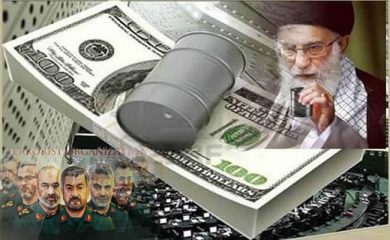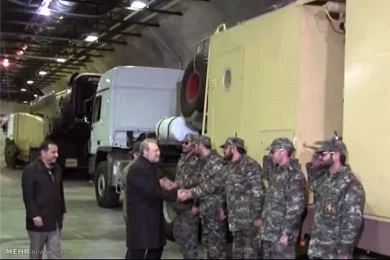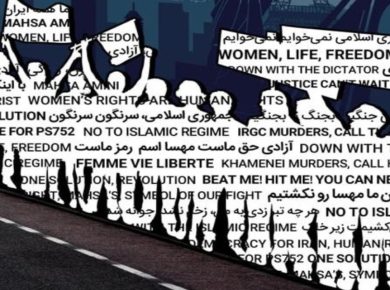The slogan “Women, Life, Freedom” (زن، زندگی، آزادی) has become a powerful rallying cry for justice, equality, and resistance against state oppression in Iran. Born from the tragic death of Mahsa Amini in 2022, this movement has ignited nationwide protests, challenging the Islamic Republic’s authoritarian rule and the IRGC’s brutal repression. More than just a chant, this phrase represents a deep-rooted struggle for women’s rights, democracy, and an end to state violence.
Despite mass arrests, executions, and censorship, Iranian women continue to resist—removing their hijabs in defiance, organizing protests, and using digital platforms to expose the IRGC’s human rights violations. The movement has spread beyond Iran’s borders, with global solidarity amplifying their fight.
This update explores:
• The origins and significance of “Women, Life, Freedom.”
• How the Iranian regime, led by the IRGC, has responded.
• The global impact and continued relevance of the movement.
• How the world can support Iranian women in their ongoing struggle.
1. The Origins and Meaning of “Women, Life, Freedom”
A. From Kurdish Activism to Nationwide Resistance
The phrase “Women, Life, Freedom” has Kurdish roots, originally used in Kurdish feminist struggles against oppression. When Mahsa Amini, a Kurdish-Iranian woman, was killed in police custody for allegedly wearing her hijab “improperly,” the slogan became the defining chant of Iran’s protests.
It symbolizes:
• Women: The central role of women in leading the fight for freedom.
• Life: The demand for basic human rights, dignity, and a life free from fear.
• Freedom: The aspiration for political change, democracy, and an end to dictatorship.
B. Why This Slogan Resonates Across Iran
Unlike past protests in Iran, which were often driven by economic concerns, the “Women, Life, Freedom” movement is deeply ideological, challenging the very foundation of the Islamic Republic’s patriarchal and authoritarian structure.
Key reasons it resonates nationwide:
✔ It unites people across generations, ethnicities, and social classes.
✔ It exposes gender oppression as central to the regime’s control.
✔ It connects women’s rights to the broader fight for democracy.
By removing their hijabs, women are challenging not just a dress code but the entire power structure upheld by the IRGC and Iran’s ruling clerics.
2. The IRGC’s Brutal Response to the Movement
A. State Crackdowns and Mass Arrests
The Islamic Revolutionary Guard Corps (IRGC) has led the violent suppression of the “Women, Life, Freedom” movement, using:
• Arbitrary arrests of women who refuse to wear the hijab.
• Torture, sexual violence, and forced confessions in prison.
• Surveillance, digital repression, and internet blackouts to block communication.
• State executions and show trials to intimidate protesters.
According to human rights organizations, thousands have been arrested, tortured, or killed, with the IRGC targeting women, journalists, and activists.
B. Targeting Women Leaders and Journalists
The IRGC’s crackdown has disproportionately targeted female journalists and human rights activists, including:
✔ Niloofar Hamedi – The journalist who broke the story of Mahsa Amini’s death. Arrested and held in solitary confinement.
✔ Nasrin Sotoudeh – A human rights lawyer defending women’s rights, sentenced to 38 years in prison and 148 lashes.
✔ Sepideh Gholian – A journalist repeatedly arrested and tortured, yet continues to resist publicly.
By silencing women journalists, the IRGC hopes to erase the truth—but the world is watching.
C. Hijab Crackdowns as a Tool of Fear
In 2023-2024, the Iranian regime escalated its compulsory hijab enforcement, including:
• Deploying facial recognition technology to identify unveiled women.
• Forcing businesses to deny service to women without hijabs.
• Increasing moral police patrols to intimidate women in public.
Yet, Iranian women continue to resist, showing that the “Women, Life, Freedom” movement is far from over.
3. The Global Impact of “Women, Life, Freedom”
A. Worldwide Protests and Solidarity
The movement has sparked global protests, with Iranian diaspora communities and women’s rights activists leading demonstrations in:
✔ Berlin, London, Paris, and Washington, D.C.
✔ Universities and international women’s rights organizations.
✔ Social media campaigns spreading awareness worldwide.
The slogan has become a universal call for gender equality, resonating with feminist movements across the world.
B. Political and Diplomatic Consequences
The movement has led to:
✔ Calls to designate the IRGC as a terrorist organization.
✔ Sanctions on Iranian officials responsible for human rights abuses.
✔ United Nations investigations into gender-based violence in Iran.
However, many governments have yet to take firm action, highlighting the need for stronger global pressure.
4. How the World Can Support Iranian Women
A. Designating the IRGC as a Terrorist Organization
The United States has already designated the IRGC as a terrorist entity, but:
• The European Union and UK must follow to isolate the IRGC financially.
• Sanctions should specifically target officials responsible for violence against women.
• The UN and human rights groups must hold Iran accountable for its abuses.
B. Supporting Iranian Women Digitally and Legally
✔ Tech companies must ensure secure communication tools for Iranian women.
✔ Legal advocacy groups should provide support for imprisoned activists.
✔ Governments should fast-track asylum for at-risk Iranian women.
C. Amplifying Women’s Voices
The world must:
✔ Support Iranian women journalists who expose the regime’s crimes.
✔ Encourage global media coverage of the movement.
✔ Keep Mahsa Amini’s name alive, ensuring her story is never forgotten.
5. The Future of “Women, Life, Freedom”
A. Iranian Women Will Not Back Down
Despite the regime’s brutality, Iranian women remain defiant.
• Protests continue in universities, public spaces, and online.
• Women are forming underground networks to resist oppression.
• Even in prison, activists continue to write, organize, and inspire.
The movement is evolving, turning into a long-term revolution.
B. A Symbol of Broader Change
The fight for gender equality in Iran is not separate from the fight for democracy.
• Women’s rights and political freedom are interconnected.
• As long as “Women, Life, Freedom” remains a rallying cry, the movement lives on.
“They tried to bury us. They didn’t know we were seeds.”
Conclusion: The Struggle Continues
The slogan “Women, Life, Freedom” is more than words—it is a promise of change, a call for justice, and a beacon of hope for a future where Iranian women are free.
The IRGC’s repression cannot stop the growing global movement in support of Iranian women’s rights. The world must continue to amplify their voices, sanction their oppressors, and support their fight.
Join Our Newsletter!
Stay informed with the latest updates, news, and ways to take action in the fight for justice and global security. Sign up now to get updates delivered straight to your inbox!





